This is an old revision of this page, as edited by Conte di Cavour (talk | contribs) at 16:03, 21 August 2008 (→20th century & early 21st century). The present address (URL) is a permanent link to this revision, which may differ significantly from the current revision.
Revision as of 16:03, 21 August 2008 by Conte di Cavour (talk | contribs) (→20th century & early 21st century)(diff) ← Previous revision | Latest revision (diff) | Newer revision → (diff)- For a topic outline on this subject, see List of basic Italy topics. For other uses, see Italy (disambiguation).
| Italian RepublicRepubblica Italiana | |
|---|---|
 Flag
Flag
 Coat of arms
Coat of arms
| |
| Anthem: Il Canto degli Italiani (also known as Inno di Mameli) The Song of the Italians | |
 Location of Italy (dark green) Location of Italy (dark green)– in Europe (light green & dark grey) | |
| Capitaland largest city | Rome |
| Official languages | Italian |
| Demonym(s) | Italian |
| Government | Parliamentary republic |
| • President | Giorgio Napolitano |
| • Prime Minister | Silvio Berlusconi |
| Formation | |
| • Unification | 17 March 1861 |
| • Republic | 2 June 1946 |
| Area | |
| • Total | 301,318 km (116,340 sq mi) (71st) |
| • Water (%) | 2.4 |
| Population | |
| • October 2007 estimate | 59,619,290 (23rd) |
| • October 2001 census | 57,110,144 |
| • Density | 197.6/km (511.8/sq mi) (54th) |
| GDP (PPP) | 2007 estimate |
| • Total | $1.888 trillion (8th) |
| • Per capita | $32,319 (20th) |
| GDP (nominal) | 2007 estimate |
| • Total | $2.067 trillion (7th) |
| • Per capita | $35,386 (18th) |
| Gini (2000) | 36 medium inequality |
| HDI (2005) | Error: Invalid HDI value (20th) |
| Currency | Euro (€) (EUR) |
| Time zone | UTC+1 (CET) |
| • Summer (DST) | UTC+2 (CEST) |
| Calling code | 39 |
| ISO 3166 code | IT |
| Internet TLD | .it |
| |
Italy (Template:Lang-it), officially the Italian Republic, (Template:Lang-it), is located on the Italian Peninsula in Southern Europe, and on the two largest islands in the Mediterranean Sea, Sicily and Sardinia. Italy shares its northern Alpine boundary with France, Switzerland, Austria and Slovenia. The independent states of San Marino and the Vatican City are enclaves within the Italian Peninsula, while Campione d'Italia is an Italian exclave in Switzerland.
Italy has been the home of many European cultures, such as the Etruscans and the Romans, and later was the birthplace of the universities and of the movement of the Renaissance, that began in Tuscany and spread all over Europe. Italy's capital Rome was for centuries the center of Western civilization, it also spawned the Baroque movement and seats the Catholic Church. Italy possessed a colonial empire from the mid-nineteenth century to the mid-twentieth century.
Today, Italy is a democratic republic and a developed country with the 8th-highest Quality-of-life index rating in the world. It is a founding member of what is now the European Union (having signed the Treaty of Rome in 1957), and a founding member of the North Atlantic Treaty Organization (NATO). It is a member of the G8 (having the world's 7th largest nominal GDP), Organisation for Economic Co-operation and Development (OECD), World Trade Organization (WTO), the Council of Europe, the Western European Union, the Central European Initiative, and a Schengen state. It has the world's 8th largest defence budget and shares NATO's nuclear weapons. On January 1 2007, Italy began a two year term as a non-permanent member of the United Nations Security Council.
Etymology
The origin of the term Italy (It: Italia), from Latin Italia, is uncertain. According to one of the more common explanations, the term was borrowed through Greek, from Oscan Víteliú, meaning "land of young cattle" (cf. Lat vitulus "calf", Umb vitlo "calf") and named for the god of cattle, Mars. The bull was a symbol of the southern Italian tribes and is often depicted goring the Roman wolf as a defiant symbol of free Italy during the Samnite Wars.
The name Italia applied to a part of what is now southern Italy. According to Antiochus of Syracuse, it originally only referred to the southern portion of the Bruttium peninsula (modern Calabria), but by his time Oenotrians and Italy had become synonymous, and the name also applied to most of Lucania as well. The Greeks gradually came to apply the name "Italia" to a larger region, but it was not until the time of the Roman conquests that the term was expanded to cover the entire peninsula.
History
Main article: History of ItalyPrehistory to Roman Empire
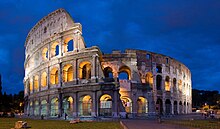
Excavations throughout Italy reveal a modern human presence dating back to the Palaeolithic period some 200,000 years ago. In the 8th and 7th centuries BC Greek colonies were established all along Sicily and the southern part of the Italian Peninsula. Subsequently Romans refereed to this area as Magna Graecia as it was so densely inhabited by Greeks. Ancient Rome, at first a small agricultural community founded circa 8th century BC, grew the next centuries into a colossal empire encompassing the whole Mediterranean Sea, in which Ancient Greek and Roman cultures merged into one civilization, so influential that parts of it survive in modern law, administration, philosophy and arts forming the ground where Western civilization is based upon. In its twelve-century existence, it transformed from a republic to monarchy and finally to autocracy. In steady decline since 2nd century AD, the empire finally broke into two parts in 285 AD, a western and an eastern. The western part under the pressure of Goths finally dissolved leaving the Italian peninsula divided into small independent kingdoms and feuding city states for the next 14 centuries, and the eastern part as the sole heir to Roman legacy.
Middle Ages


Following a short recapture of the peninsula by Byzantine Emperor, Justinian at 6th cen. AD from the Ostrogoths a new wave of Germanic tribes, the Lombards, soon arrived to Italy from the north. For several centuries the armies of the Byzantines were strong enough to prevent Arabs, Holy Roman Empire, or the Papacy from establishing a unified Italian Kingdom, but at the same time too weak to fully unify the former Roman lands. Nevertheless during early Middle Ages Imperial orders such as the Carolingians, the Ottonians and Hohenstaufens managed to impose their overlordship in Italy.
Italy's regions eventually interlocked to their neighbouring empires' conflicting interests and would remain divided up to 19th century. It was during this vacuum of authority that the region saw the rise of Signoria and Comune. In the anarchic conditions that often prevailed in medieval Italian city states, people looked to strong men to restore order and disarm the feuding elites. In times of anarchy or crisis, cities sometimes offered the Signoria to individuals perceived as strong enough to save the state, most notably Della Scala family in Verona, Visconti in Milan and Medici in Florence.
Italy during this period became notable for its merchant Republics. These city-states, oligarchical in reality, had a dominant merchant class which under a relative freedom nurtured academic and artistic advancement. The four classic Maritime Republics in Italy were Venice, Genoa, Pisa, Amalfi reflecting the temporal sequence of their dominance.
Venice and Genoa were Europe's gateway to trade with the East, with the former producer of the renown venetian glass, whilst Florence was the capital of silk, wool, banks and jewelry. The Maritime Republics were heavily involved in the Crusades, taking advantage of the new political and trading opportunities, most evidently in the conquest of Zara and Constantinople funded by Venice.
During late Middle Ages Italy was divided into smaller city states and territories: the kingdom of Naples controlled the south, the Republic of Florence and the Papal States the centre, the Genoese and the Milanese the north and west, and the Venetians the east. Fifteenth-century Italy was one of the most urbanised areas in Europe and the birthplace of Renaissance. Florence, in particular with the writings of Dante Alighieri (1265–1321), Francesco Petrarch (1304–1374) and Giovanni Boccaccio (c. 1313–1375), as well as the painting of Giotto di Bondone (1267–1337) is considered the center of this cultural movement. Scholars like Niccolò de' Niccoli and Poggio Bracciolini scoured the libraries in search of works of classical authors as Plato, Aristotle, Euclid, Ptolemy, Cicero and Vitruvius.
The Black Death pandemic in 1348 left its mark on Italy by killing one third of the population. The recovery from the disaster led to a resurgence of cities, trade and economy which greatly stimulated the successive phase of the Humanism and Renaissance. In 1494 the French king Charles VIII opened the first of a series of invasions, lasting up to sixteenth century, and a competition between France and Spain for the possession of the country. Ultimately Spain prevailed through the Treaty of Cateau-Cambresis which recognised Spanish dominance over the Duchy of Milan and the Kingdom of Naples. The holy alliance between Habsburg Spain and the Holy See resulted in the systematic persecution of any Protestant movement. Austria succeeded Spain as hegemon in Italy under the Peace of Utrecht. Through Austrian domination, the northern part of Italy, gained economic dynamism and intellectual fervor. The French Revolution and the Napoleonic Wars (1796–1815) introduced the ideas of equality, democracy, law and nation.
Kingdom of Italy (1861-1946)
Main article: Kingdom of ItalyThe creation of the Kingdom of Italy was the result of the efforts by Italian nationalists and monarchists loyal to the House of Savoy to establish a united kingdom encompassing the entire Italian Peninsula. In the context of 1848 liberal revolutions that swept through Europe an unsuccessful war was declared on Austria. Giuseppe Garibaldi popular amongst southern Italians led the Italian republican drive for unification in southern Italy , while the northern Italian monarchy of the Kingdom of Piedmont-Sardinia whose government was led by Camillo Benso, conte di Cavour, had the ambition of establishing a united Italian state under its rule. The kingdom successfully challenged Austrian Empire in the Second Italian War of Independence with the help of Napoleon III, liberating the Lombardy-Venetia. In 1866 Victor Emmanuel II aligned the kingdom to Prussia during the Austro-Prussian War waging the Third Italian War of Independence which allowed Italy to annex Venice. In 1870, as France during the disastrous Franco-Prussian War abandoned its positions in Rome, Italy rushed to fill the power gap by taking over the Papal State from French sovereignty. Italian unification finally was achieved, and shortly afterwards Italy's capital was moved to Rome.
As Northern Italy was industrialized and modernized, the south became overcrowded, forcing millions of people to emigrate for a better life abroad. The Sardinian Statuto Albertino of 1848, extended to the whole Kingdom of Italy in 1861, provided for basic freedoms, but the electoral laws excluded the non-propertied and uneducated classes from voting. In 1913 male universal suffrage was allowed. The Socialist Party became the main political party, outclassing the traditional liberal and conservative organisations. Starting from the last two decades of the nineteenth century, Italy developed into a colonial power by forcing Somalia, Eritrea and later Libya and Dodecanese under its rule. During World War I Italy stayed at first neutral, but in 1915, signed the London Pact entering Entente, promised Trento, Trieste, Istria, Dalmatia and parts of Ottoman Empire. During the war, 600,000 Italians died and the economy collapsed. Under the Peace Treaty of Saint-Germain, Italy obtained just Bolzano-Bozen, Trento, Trieste and Istria in a victory defined as "mutilated" by public.
The turbulence that followed the devastations of World War I, inspired by the Russian Revolution, led to turmoil and anarchy. The liberal establishment, fearing a socialist revolution, started to endorse the small National Fascist Party, led by Benito Mussolini. In October 1922 the fascists attempted a coup (the "Marcia su Roma", i.e. March on Rome); but the king ordered the army not to intervene, instead forming an alliance with Mussolini. Over the next few years, Mussolini banned all political parties and curtailed personal liberties thus forming a dictatorship. In 1935, Mussolini subjugated Ethiopia after a surprisingly lengthy campaign. This resulted in international alienation and the exodus of the country from the League of nations. A first pact with Nazi Germany was concluded in 1936, and a second in 1938. Italy strongly supported Franco in the Spanish civil war and Hitler's annexation of Austria and Czechoslovakia. On April 7 1939 Italy occupied Albania, a de facto protectorate for decades and entered World War II in 1940 taking part in the late stages of the Battle of France. Mussolini wanting a quick and swift victory which would emulate Hitler's blitzkrieg in Poland and France, invaded Greece in October 1940 via Albania but was forced to a humiliating defeat after a few months. At the same time Italy after initially conquering British Somalia, saw an allied counter-attack leading to the loss of all possessions in the Horn of Africa. Italy was also defeated by British forces in North Africa and was only saved by the urgently dispatched German Africa Corps led by Erwin Rommel. Italy was invaded by Allies in June 1943 leading to the collapse of the fascist regime and the arrest of Mussolini. In September 1943, Italy surrendered. Immediately Germany invaded its former ally with the country becoming a battlefield for the rest of the war. The country was liberated on April 25 1945.
Italian Republic (1946-)
Main article: History of the Italian Republic
In 1946 Vittorio Emanuele III's son, Umberto II, was forced to abdicate. Italy became a Republic after a referendum held on June 2 1946, a day celebrated since as Republic Day. This was the first election in Italy allowing women to vote. The Republican Constitution was approved and came into force on January 1 1948. Under the Paris Peace Treaties of 1947, the eastern border area was lost to Yugoslavia and the free territory of Trieste was divided between the two states. The Marshall Plan in 1949 helped to revive the Italian economy which in 1950s and 1960s enjoyed a prolonged economic growth. Italy is a founding member of European Union (EU). In the 1970s and 1980s the country experienced the Years of Lead, a period characterised by widespread social conflicts and terrorist acts carried out by extra-parliamentary movements. The assassination of the leader of the Christian Democracy , Aldo Moro, led to the end of a historic compromise between the DC and the Communist Party.
From 1992 to 1997, the Italian economy faced significant challenges with massive government debt, extensive corruption, and organized crime's considerable influence collectively called the political system Tangentopoli. The Tangentopoli scandals involved all major parties, and between 1992 and 1994 the DC underwent a severe crisis splitting up into several factions, including the Italian People's Party and the Christian Democratic Center. The Italian Socialist Party (PSI) completely dissolved. The 1994 elections put media magnate Silvio Berlusconi into the Prime Minister's seat. However he was forced to step down in December when Lega Nord withdrew its support. In April 1996, national elections led to the victory of a centre-left coalition under the leadership of Romano Prodi. Prodi's first government became the third-longest to stay in power before he narrowly lost a vote of confidence, by three votes, in October 1998. A new government was formed by Massimo D'Alema, but in April 2000 he resigned. In 2001 the centre-right formed government and Silvio Berlusconi was able to remain in power for a complete five year mandate, but with two different governments. The first one (2001–2005) became the longest government in post-war Italy. Italy participated in the US-led military coalition in Iraq. The elections in 2006 won by centre-left, allowed Prodi to form his second government but in early 2008, he resigned because of the collapse of his coalition. In the ensuing new early elections in April 2008, Silvio Berlusconi convincingly won to form a government for the third time.
Geography
Main article: Geography of Italy Main article: Volcanism in Italy
Topography
Italy occupies a long, boot-shaped peninsula, surrounded on the west by the Tyrrhenian Sea and on the east by the Adriatic Sea. It is bounded by France, Switzerland, Austria, and Slovenia to the north. The Apennine Mountains form the peninsula's backbone; the Alps form its northern boundary. The largest of its northern lakes is Garda (143 sq mi; 370 km²); the Po, its principal river, flows from the Alps on Italy's western border and crosses the great Padan plain to the Adriatic Sea. Several islands form part of Italy; the largest are Sicily (9,926 sq mi; 25,708 km²) and Sardinia (9,301 sq mi; 24,090 km²). There are several active volcanoes in Italy: Etna, the largest active volcano in Europe; Vulcano; Stromboli; and Vesuvius, the only active volcano on the mainland of Europe.

Climate
Main article: Climate of ItalyThe climate in Italy is highly diverse and can be far from the stereotypical Mediterranean climate depending on the location. Most of the inland northern areas of Italy (for example Turin, Milan and Bologna) have a continental climate often classified as Humid subtropical climate (Köppen climate classification Cfa). The coastal areas of Liguria and most of the peninsula south of Florence generally fit the Mediterranean stereotype (Köppen climate classification Csa). The coastal areas of the peninsula can be very different from the interior higher altitudes and valleys, particularly during the winter months when the higher altitudes tend to be cold, wet, and often snowy. The coastal regions have mild winters and warm and generally dry summers, although lowland valleys can be quite hot in summer.
Government and politics
Main article: Politics of ItalySee also: List of Prime Ministers of Italy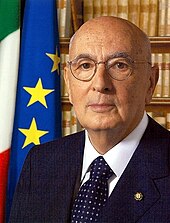
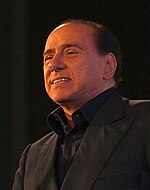
The 1948 Constitution of Italy established a bicameral parliament (Parlamento), consisting of a Chamber of Deputies (Camera dei Deputati) and a Senate (Senato della Repubblica), a separate judiciary, and an executive branch composed of a Council of Ministers (cabinet) (Consiglio dei ministri), headed by the prime minister (Presidente del consiglio dei ministri).
The President of the Italian Republic (Presidente della Repubblica) is elected for seven years by the parliament sitting jointly with a small number of regional delegates. The president nominates the prime minister, who proposes the other ministers (formally named by the president). The Council of Ministers must obtain a confidence vote from both houses of Parliament. Legislative bills may originate in either house and must be passed by a majority in both.
The houses of parliament are popularly and directly elected through a complex electoral system (latest amendment in 2005) which combines proportional representation with a majority prize for the largest coalition (Chamber). All Italian citizens older than 18 can vote. However, to vote for the senate, the voter must be at least 25 or older. The electoral system in the Senate is based upon regional representation. During the elections in 2006, the two competing coalitions were separated by few thousand votes, and in the Chamber the centre-left coalition (L'Unione; English: The Union) got 345 Deputies against 277 for the centre-right one (Casa delle Libertà; English: House of Freedoms), while in the Senate L'Unione got only two Senators more than absolute majority. The Chamber of Deputies has 630 members and the Senate 315 elected senators; in addition, the Senate includes former presidents and appointed senators for life (no more than five) by the President of the Republic according to special constitutional provisions. As of May 15 2006 there are seven life senators (of which three are former Presidents). Both houses are elected for a maximum of five years, but both may be dissolved by the President before the expiration of their normal term if the Parliament is unable to elect a stable government. In the post war history, this has happened in 1972, 1976, 1979, 1983, 1994, 1996 and 2008.
A peculiarity of the Italian Parliament is the representation given to Italian citizens permanently living abroad (about 2.7 million people). Among the 630 Deputies and the 315 Senators there are respectively 12 and 6 elected in four distinct foreign constituencies. Those members of Parliament were elected for the first time in April 2006 and they have the same rights as members elected in Italy.
The Italian judicial system is based on Roman law modified by the Napoleonic code and later statutes. The Constitutional Court of Italy (Corte Costituzionale) rules on the conformity of laws with the Constitution and is a post-World War II innovation.
Foreign relations
Main article: Foreign relations of ItalySee also: Italian Minister of Foreign Affairs
Italy was a founding member of the European Community—now the European Union (EU). Italy was admitted to the United Nations in 1955 and is a member and strong supporter of the North Atlantic Treaty Organization (NATO), the Organisation for Economic Co-operation and Development (OECD), the General Agreement on Tariffs and Trade/World Trade Organization (GATT/WTO), the Organization for Security and Co-operation in Europe (OSCE), and the Council of Europe. Its recent turns as rotating Presidency of international organisations include the CSCE (the forerunner of the OSCE) in 1994 G8, the EU in 2001 and from July to December 2003.
Italy supports the United Nations and its international security activities. Italy deployed troops in support of UN peacekeeping missions in Somalia, Mozambique, and East Timor and provides support for NATO and UN operations in Bosnia, Kosovo and Albania. Italy deployed over 2,000 troops to Afghanistan in support of Operation Enduring Freedom (OEF) in February 2003. Italy still supports international efforts to reconstruct and stabilize Iraq, but it has withdrawn its military contingent of some 3,200 troops as of November 2006, maintaining only humanitarian workers and other civilian personnel.
In August 2006 Italy sent about 3,000 soldiers to Lebanon for the United Nations' peacekeeping mission UNIFIL. Furthermore, since 2 February 2007 an Italian, Claudio Graziano is the commander of the UN force in the country.
Military
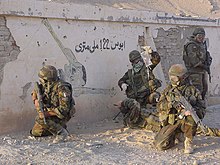


Article 11 of the Italian Constitution says: "Italy rejects war as an instrument of aggression against the freedoms of others peoples and as a means for settling international controversies; it agrees, on conditions of equality with other states, to the limitations of sovereignty necessary for an order that ensures peace and justice among Nations; it promotes and encourages international organizations having such ends in view".
The Italian armed forces are under the command of the Italian Supreme Defense Council, presided over by the President of the Italian Republic. The total number of military personnel is approximately 308,000. Italy has the eighth-highest military expenditure in the world. Italy shares nuclear weapons with NATO, in the form of US nuclear weapons leased to Italy.
The Italian armed forces are divided into four branches:
Army
The Esercito Italiano (the Italian Army) is the ground defense force of the Italian Republic. It has recently (July 29, 2004) become a professional all-volunteer force of 115,687 active duty personnel. Its most famous combat vehicles are Dardo, Centauro and Ariete, and Mangusta attack helicopters, recently deployed in UN missions; but the Esercito Italiano also has at its disposal a large number of Leopard 1 and M113 armored vehicles.
Navy
The Marina Militare (the Italian Navy) is one of the four branches of the military forces of Italy. It was created in 1946, as the Navy of the Italian Republic, from the Regia Marina. Today's Marina Militare is a modern navy with a strength of 35,261 and ships of every type, such as aircraft carriers, destroyers, modern frigates, submarines, amphibious ships and other smaller ships such as oceanographic research ships.
The Marina Militare is now equipping herself with a bigger aircraft carrier (the Cavour), new destroyers, submarines and multipurpose frigates. In modern times, the Marina Militare, being a member of the North Atlantic Treaty Organization (NATO), has taken part in many coalition peacekeeping operations around the world. The Marina Militare is considered the fourth strongest navy of the world.
Air Force
The Aeronautica Militare Italiana is the air force of Italy. It was founded as an independent service arm on 28 March, 1923, by King Vittorio Emanuele III as the Regia Aeronautica (which translates to "Royal Air Force"). After World War II, when Italy was made a republic by referendum, the Regia Aeronautica was given its current name. Today the Aeronautica Militare has a strength of 45,879 and operates 585 aircraft, including 219 combat jets and 114 helicopters. As a stopgap and as replacement for leased Tornado ADV interceptors, the AMI has leased 30 F-16A Block 15 ADF and four F-16B Block 10 Fighting Falcons, with an option for some more. The coming years also will see the introduction of 121 EF2000 Eurofighter Typhoons, replacing the leased F-16 Fighting Falcons. Furthermore updates are foreseen on the Tornado IDS/IDT and the AMX-fleet. The transport capacity is guaranteed by a fleet of 22 C-130Js, also a completely new developed G222, called C-27J Spartan (12 aircraft ordered), will enter service replacing the G222's. The Italian air force is also planning on purchasing F-35, although they have not been distributed around the world yet.
Gendarmerie
The Carabinieri are the gendarmerie and military police of Italy, providing the republic with a national police service. At the Sea Islands Conference of the G8 in 2004, the Carabinieri was given the mandate to establish a Center of Excellence for Stability Police Units (CoESPU) to spearhead the development of training and doctrinal standards for civilian police units attached to international peacekeeping missions.
Regions, provinces, and municipalities
Main articles: Regions of Italy, Provinces of Italy, and Municipalities of ItalyItaly is subdivided into 20 regions (regioni, singular regione). Five of these regions have a special autonomous status that enables them to enact legislation on some of their local matters, and are marked by an *. It is further divided into 109 provinces (province) and 8,101 municipalities (comuni).
DemographicsMain article: Demography of ItalyPopulationIn October 2007, Italy officially reached more than 59.5 million persons. Italy currently has the fourth largest population in the European Union, and the 23rd largest population in the world. Italy's population density at 196.1 persons per kilometre is the fifth highest in the European Union. The highest density is in Northern Italy, as one third of the country contains almost half of the Italian population. After World War II, Italy saw an economic boom which lead to rural population moving to the cities, and in the same time it turned from a nation characterized by massive emigration to a net immigrant-receiving country. High fertility persisted until the 70s when it plunged below replacement so as of 2007, one in five Italians was pensioners. Despite this, thanks mainly to the immigration of 80s and 90s, in 2000s Italy saw natural population growth for the first time in years. Largest cities      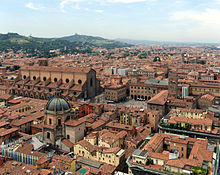 Italian cities with a population of 300,000 or more (ISTAT data, December 2006):
Metropolitan areasAccording to the OECD, these are the major Italian metropolitan areas:
Migration and ethnicityItaly is a destination for immigrants from all over the world. At the end of 2006, foreigners comprised 5% of the population or 2,938,922 persons, an increase of 270,000 since the previous year. In some Italian cities, such as Brescia, Milan, Padua, and Prato, immigrants total more than 10% of the population. The most recent wave of migration has been from surrounding European nations, particularly Eastern Europe, replacing North Africans as a major source of migrants. Around 500,000 Romanians are officially registered as living in Italy, but unofficial estimates put the actual number at double that figure or perhaps even more. As of 2006, migrants came from other parts of Europe (47.75%), North Africa (17.77%), Asia (17.43%), Latin America (8.90%). Smaller groups came from sub-Saharan Africa, and North America.
ReligionMain article: Religion in ItalySee also: Christianity in Italy, Islam in Italy, Jews in Italy, Buddhism in Italy, and List of Italian religious minority politicians
Roman Catholicism is by far the largest religion in the country, although the Catholic Church is no longer officially the state religion. 87.8% of Italians identified as Roman Catholic , although only about one-third of these described themselves as active members (36.8%). Other Christian groups in Italy include more than 700,000 Eastern Orthodox Christians, including 470,000 newcomersand some 180,000 Greek Orthodox, 550,000 Pentecostals and Evangelicals (0.8%), of whom 400,000 are members of the Assemblies of God, 235,685 Jehovah's Witnesses (0.4%), 30,000 Waldensians, 25,000 Seventh-day Adventists, 22,000 Mormons, 15,000 Baptists (plus some 5,000 Free Baptists), 7,000 Lutherans, 5,000 Methodists (affiliated to the Waldensian Church). The country's oldest religious minority is the Jewish community, comprising roughly 45,000 people. It is no longer the largest non-Christian group. As a result of significant immigration from other parts of the world, some 825,000 Muslims (1.4% of the total population) live in Italy, though only 50,000 are Italian citizens. In addition, there are 110,000 Buddhists (0.2%), 70,000 Sikhs, and 70,000 Hindus (0.1%) in Italy. EconomyMain article: Economy of ItalySee also: List of Italian companies According to GDP calculations, Italy was ranked as the seventh-largest economy in the world in 2006, behind the United States, Japan, Germany, China, the United Kingdom, and France, and the fourth-largest in Europe. According to the OECD, in 2004 Italy was the world's sixth-largest exporter of manufactured goods. This economy remains divided into a developed industrial north, dominated by private companies, and a less developed agricultural south. In the Index of Economic Freedom 2008 it ranked 64th of 162 countries, or 29th of 41 European countries, the lowest rating in the EU-15 and behind many ex-communist European countries. Italy has often been called a sick man of Europe, with governments having problems in pursuing reform programs. According to World Bank data, Italy has high levels of freedom to invest, do business, and trade. On the other hand, Italy has inefficient bureaucracy, relatively low property rights and high levels of corruption (compared to other European countries), heavy taxes, and heavy public consumption at around half of GDP. Italy has been in economic decline compared to most other EU-15 countries. Most raw materials needed by Italian industries, and more than 75% of energy requirements, are imported. Over the past decade, Italy has pursued a tight fiscal policy in order to meet the requirements of the Economic and Monetary Union and has benefited from lower interest and inflation rates. Italy joined the Euro from its introduction in 1999. Italy's economic performance has at times lagged behind that of its EU partners, and the current government has enacted numerous short-term reforms aimed at improving competitiveness and long-term growth. It has moved slowly, however, on implementing certain structural reforms favoured by economists, such as lightening the high tax burden and overhauling Italy's rigid labour market and expensive pension system, because of the economic slowdown and opposition from labour unions. Italy has a smaller number of world class multinational corporations than other economies of comparable size. Instead, the country's main economic strength has been its large base of small- and medium-sized companies. Some of these companies manufacture products that are technologically moderately advanced and therefore face increasing competition from China and other emerging Asian economies which are able to undercut them on labour costs. These Italian companies are responding to the Asian competition by concentrating on products with a higher technological content, while moving lower-tech manufacturing to plants in countries where labour is less expensive. The small average size of Italian companies remains a limiting factor, and the government has been working to encourage integration and mergers and to reform the rigid regulations that have traditionally been an obstacle to the development of larger corporations in the country. Italy's major exports are motor vehicles (Fiat Group, Aprilia, Ducati, Piaggio), chemicals, petrochemicals (Eni), electricity (Enel, Edison), home appliances (Merloni, Candy), aerospace and defense tech (Alenia, Agusta, Finmeccanica), firearms (Beretta); but the country's more famous exports are in the fields of fashion (Armani, Valentino, Versace, Dolce & Gabbana, Benetton, Prada, Luxottica), food industry (Ferrero, Barilla Group, Martini & Rossi, Campari, Parmalat), luxury vehicles (Ferrari, Maserati, Lamborghini, Pagani) and motoryachts (Ferretti, Azimut). Tourism is very important to the Italian economy: with over 37 million tourists a year, Italy is ranked as the fifth major tourist destination in the world. TransportMain article: Transport in Italy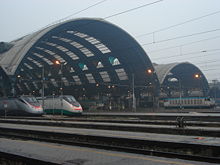 The railway network in Italy totals 16,627 kilometres (10,331 mi), ranking the country 17th in the world , and is operated by Ferrovie dello Stato. High speed trains include ETR-class trains, of which the ETR 500 travels at 300 km/h (190 mph). In 1991 Treno Alta Velocità SpA was created, a special purpose entity owned by RFI (itself owned by Ferrovie dello Stato) for the planning and construction of high-speed rail lines along Italy's most important and saturated transport routes. These lines are often referred as "TAV" lines. The purpose of TAV construction is to aid travel along Italy's most saturated rail lines and to add tracks to these lines, namely the Milan-Naples and Turin-Milan-Venice corridors. One of the focuses of the project is to turn the rail network of Italy into a modern and high-tech passenger rail system in accordance with updated European rail standards. A secondary purpose is to introduce high-speed rail to the country and its high-priority corridors. When demand on regular lines is lessened with the opening of dedicated high-speed lines, those regular lines will be used primarily for low-speed regional rail service and freight trains. With these ideas realised, the Italian train network can be integrated with other European rail networks, particularly the French TGV, German ICE, and Spanish AVE systems. There are approximately 654,676 km(406,797 mi) of serviceable roadway in Italy, including 6,957 km (4,323 mi) of expressways. There are approximately 133 airports in Italy, including the two hubs of Malpensa International (near Milan) and Leonardo Da Vinci International (near Rome). There are 27 major ports in Italy, the largest is in Genoa, which is also the second largest in the Mediterranean Sea, after Marseille. 2,400 km (1,500 mi) of waterways traverse Italy. CultureMain articles: Culture of Italy, Cinema of Italy, Freedom of the press in Italy, and Education in Italy Further information: ]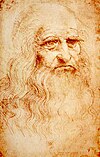 Italy did not exist as a state until the country's unification in 1861. Due to this comparatively late unification, and the historical autonomy of the regions that comprise the Italian Peninsula, many traditions and customs that are now recognized as distinctly Italian can be identified by their regions of origin. Despite the political and social isolation of these regions, Italy's contributions to the cultural and historical heritage of Europe remain immense. Italy is home to the greatest number of UNESCO World Heritage Sites (43) to date. Visual Art Italian painting is traditionally characterized by a warmth of colour and light, as exemplified in the works of Caravaggio and Titian, and a preoccupation with religious figures and motifs. Italian painting enjoyed preeminence in Europe for hundreds of years, from the Romanesque and Gothic periods, and through the Renaissance and Baroque periods, the latter two of which saw fruition in Italy. Notable artists whom fall within these periods include Michelangelo, Leonardo da Vinci, Donatello, Botticelli, Fra Angelico, Tintoretto, Caravaggio, Bernini, Titian and Raphael. Thereafter, Italy was to experience a continual subjection to foreign powers which caused a shift of focus to political matters, leading to its decline as the artistic authority in Europe. Not until 20th century Futurism, primarily through the works of Umberto Boccioni and Giacomo Balla, would Italy prove to recapture any of its former prestige as a seminal place of artistic evolution. Futurism was succeeded by the metaphysical paintings of Giorgio de Chirico, who exerted a strong influence on the Surrealists and generations of artists to follow. LiteratureMain articles: Italian literature and Italian poetrySee also: List of Italian writers and List of Italian poets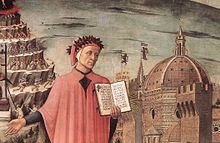 With the basis of the modern Italian language established through the Florentine poet, Dante Alighieri, whose greatest work, the Divina Commedia, is considered amongst the foremost literary statements produced in Europe during the Middle Ages, there is no shortage of celebrated literary figures; the writers and poets Giovanni Boccaccio, Giacomo Leopardi, Alessandro Manzoni, Torquato Tasso, Ludovico Ariosto, and Petrarch, whose best known vehicle of expression, the sonnet, was invented in Italy. Prominent philosophers include Giordano Bruno, Marsilio Ficino, Niccolò Machiavelli, and Giambattista Vico. Modern literary figures and Nobel laureates are nationalist poet Giosuè Carducci in 1906, realist writer Grazia Deledda in 1926, modern theatre author Luigi Pirandello in 1936, poets Salvatore Quasimodo in 1959 and Eugenio Montale in 1975, satiryst and theatre author Dario Fo in 1997. Science In science, Galileo Galilei made advancements toward the scientific revolution, and Leonardo da Vinci was the quintessential Renaissance Man. Italy has been the home of scientists and inventors: the physicist Enrico Fermi, leader of the team that built the first nuclear reactor; the astronomer Giovanni Domenico Cassini; the physicist Alessandro Volta, inventor of the electric battery; the mathematicians Lagrange and Fibonacci; Nobel Prize in Physics laureate Guglielmo Marconi, inventor of the radio; and Antonio Meucci, candidate for inventor of the telephone. MusicMain articles: Music of Italy and Music history of Italy See also: List of Italian composers From folk music to classical, music has always played an important role in Italian culture. Having given birth to opera, Italy provides many of the foundations of the classical music tradition. Instruments associated with classical music, including the piano and violin, were invented in Italy, and many of the prevailing classical music forms can trace their roots back to innovations of sixteenth and seventeenth century Italian music (such as the symphony, concerto, and sonata). Italy's most famous composers include the Renaissance composers Palestrina and Monteverdi, the Baroque composers Alessandro Scarlatti, Corelli and Vivaldi, the Classical composers Paganini and Rossini, and the Romantic composers Verdi and Puccini. Modern Italian composers such as Berio and Nono proved significant in the development of experimental and electronic music. While the classical music tradition still holds strong in Italy, as evidenced by the fame of its innumerable opera houses, such as La Scala of Milan, and San Carlo of Naples, and performers such as the pianist Maurizio Pollini, and the late tenor Luciano Pavarotti, Italians have been no less appreciative of their thriving contemporary music scene. Introduced in the early 1920s, Jazz took a particularly strong foothold in Italy, and remained popular despite the anti-American cultural policies of the Fascist regime. Today, the most notable centers of Jazz music in Italy include Milan, Rome, and Sicily. Later, Italy was at the forefront of the progressive rock movement of the 1970s, with bands like PFM and Goblin. Today, Italian pop music is represented annually with the Sanremo Music Festival, which served as inspiration for the Eurovision song contest, and the Festival of Two Worlds in Spoleto. Singers such as the Grammy winner Laura Pausini, classical crossover artist Andrea Bocelli, and European chart topper Eros Ramazzotti have attained international acclaim. SportMain article: Sport in Italy Popular sports include football, basketball (2nd national team sport since the 1950s), volleyball, waterpolo, fencing, rugby, cycling, ice hockey (mainly in Milan, Trentino-Alto Adige and Veneto), roller hockey and F1 motor racing. Winter sports are most popular in the Northern regions, with Italians competing in international games and Olympic venues. Sports are incorporated into Italian festivities like Palio (see also Palio di Siena), and the Gondola race (regatta) that takes place in Venice on the first Sunday of September. Sports venues have extended from the Gladiatorial games of Ancient Rome in the Colosseum to the Stadio Olimpico of contemporary Rome, where football clubs compete. The most popular sport in Italy is football, the Serie A being one of the most famous competitions in the world. Italy's national football team is the second most successful team in the world (with four world cup victories, the first one of which was in 1934) and the current FIFA world champion. See alsoNotesTemplate:Ent According to Mitrica, an October 2005 Romanian report estimates that 1,061,400 Romanians are living in Italy, constituting 37.2% of 2.8 million immigrants in that country but it is unclear how the estimate was made, and therefore whether it should be taken seriously. Template:Ent See also (in Italian): L. Lepschy e G. Lepschy, La lingua italiana: storia, varietà d'uso, grammatica, Milano, Bompiani Template:Ent Official French maps show the border detouring south of the main summit, and claim the highest point in Italy is Mont Blanc de Courmayeur (4,748 m), but these are inconsistent with an 1861 convention and topographic watershed analysis. References
External links
|
||||||||||||||||||||||||||||||||||||||||||||||||||||||||||||||||||||||||||||||||||||||||||||||||||||||||||||||||||||||||||||||||||||||||||||||||||||||||||||||||||||||||||||||||||||||||||||||||||||||||||||||||||||||||||||||||||||||||||||||||||||||||||||||||||||||||||||||||||||||||||||||||||||||||||||||||||||||||||||||||||||||||||||||||||||||||||||

